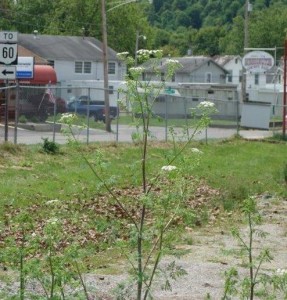Be on the Lookout for Poison Hemlock
Multiple farmers in Washington County have reported seeing hay and pasture fields being heavily infested with poison hemlock. Not only are the fields infested but the roadways in the county are littered with poison hemlock. As the name states, this weed is poisonous in both its vegetative growth stages and when dry. This was the plant used to poison and execute the Greek philosopher Socrates after he was found guilty of corrupting the minds of young Athenians and for not believing in the gods of the state. All parts of this plant are poisonous to humans and livestock so it is important to observe and remove any poison hemlock from hay or pasture fields.
Typically, grazing animals will avoid poison hemlock because of its unpalatable taste unless there is little other feed or forages available or when it’s consumed through hay. When consumed, poisoning symptoms appear rather quickly which includes: bloody feces, vomiting, paralysis, trembling, loss of coordination, pupil dilation, coma and eventually death from respiratory failure.
Since poison hemlock is a biennial (a plant that takes two years to grow from seed to fruition and die) it can be fairly easy to control. The first step in control is being able to recognize the plant. During the first year, poison hemlock produces a basal rosette and in the second year, tall erect stems are formed and can reach heights of 10 to 12 feet in moist conditions. The tall stems are hairless, purple-spotted (distinguishing feature – Fig. #1), ridged, and hollow between the nodes. The leaves (Fig. #2) are dark glossy green, fern-like, triangular, and 3-4 times pinnately compound. Poison hemlock flowers are small, white and found in umbrella-shaped clusters (Fig.#3 and Fig.#4).


Fig.#1 – Purple spotted stem Fig.#2 – Fern-like leaf

Fig.#3 – White umbel-type flower head clusters

Fig.#4 – Flower head clusters
Sometimes poison hemlock often gets confused with wild carrot (a.k.a.: lace flower, Queen Anne’s lace) due to its fern-like leaves, a single taproot, and a white umbel-type flower head . However, wild carrot has hair along its slender stem and leaf bases while poison hemlock’s stem is smooth and purple-spotted. Peak bloom for poison hemlock is in late May and early June, whereas wild carrot is just beginning to produce flowers. Wild carrot will only reach heights of 3 feet or less. Also, poison hemlock is more branch-like than wild carrot (see fig. #5).

Fig.#5 – Poison Hemlock (left) Wild Carrot (right) comparison
Once poison hemlock is successfully recognize and confirmed the next step is to take action to control it. Since poison hemlock is a biennial, it is best to control 1st-year plants by applying herbicides in the fall and for 2nd-year plants apply herbicides in the spring before the plant gets too large. According to the Ohio State University Weed Control Guide Crossbow and Remedy Ultra has the best rating for controlling poison hemlock ( rating of 9) followed by Glyphosate (8), dicamba (8), Cimarron Max (8), and 2,4-D (7). Remember these herbicides are either broadleaf killers (including legumes) or non-selective (kills both grasses and legumes). For light infestations, spot treatment may be the preferred method.
Besides chemical control, mechanical control like hand-pulling or mowing is a viable option. Mowing can be used effectively to prevent weed seed production and over time will help reduce the weed seedbank in the soil. Mow in the second year of the life-cycle before or just at the start of flowering to reduce vigor and to prevent seed set. If hand pulling, it is important to remember to wear gloves. Handling the plant can cause toxic reactions in humans.
For more information on poison hemlock or help with identifying it, please contact your local extension office.

















